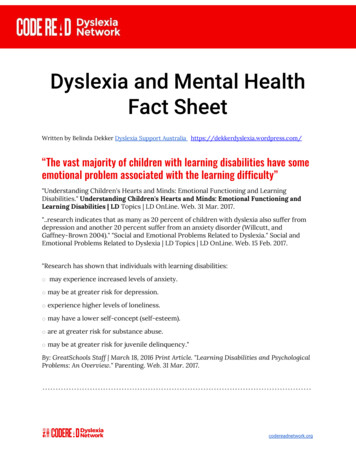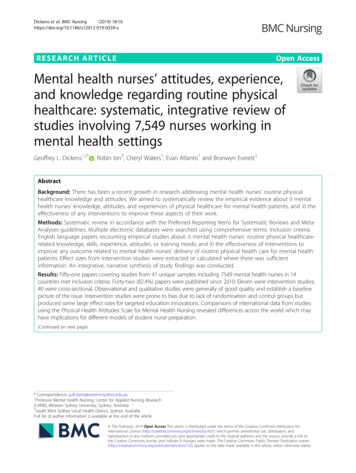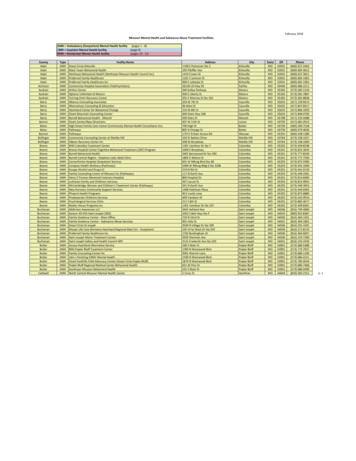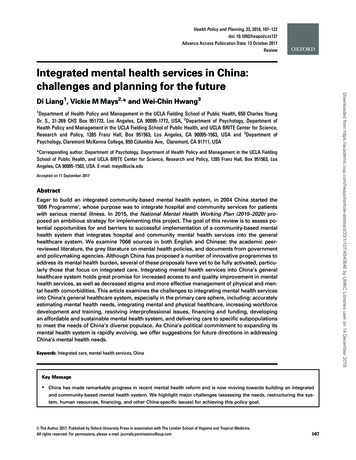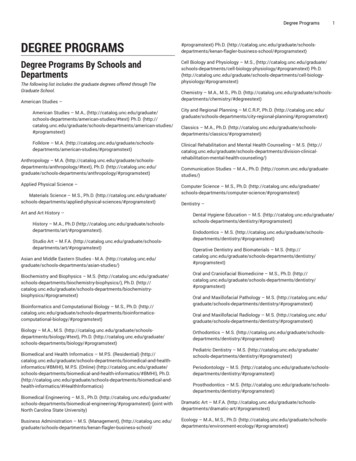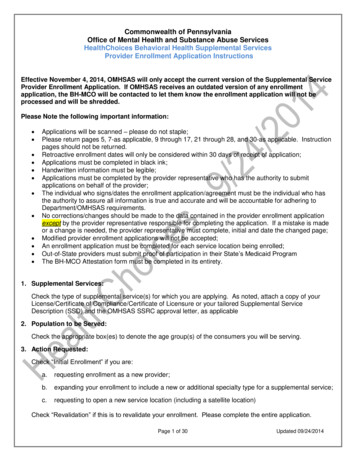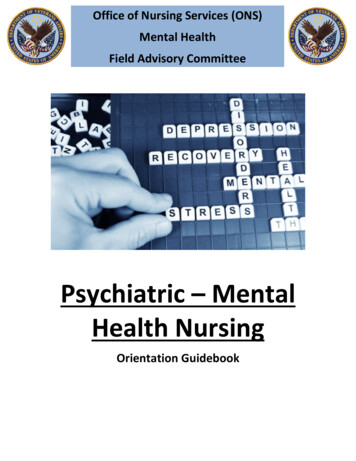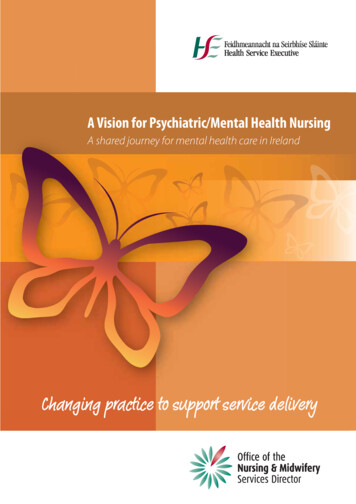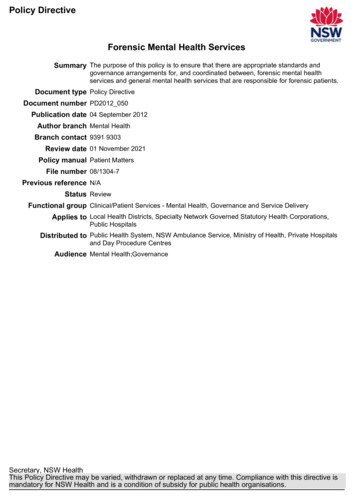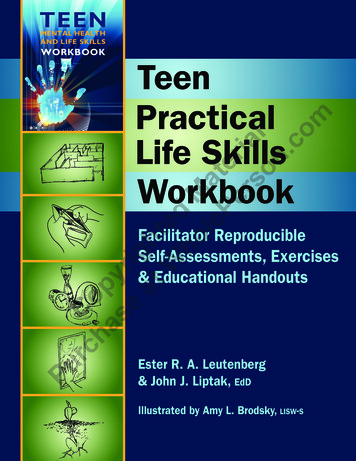
Transcription
TeenMental Healthand Life SkillsWorkbookrc Coha pse yriat ghW tedho Mle atPe errs ialon.comTeenTeenPracticalPracticalLifeSkillsLife SkillsWorkbookWorkbookFacilitator ReproducibleFacilitator cises Exercises& Educational& EducationalHandouts HandoutsEster A. LeutenbergJohn J. Liptak, EdDPuIllustrated byAmy L. Brodsky, LISW-SEster R. A. Leutenberg& John J. Liptak, EdDIllustrated by Amy L. Brodsky, lisw-sDuluth, Minnesota
rc Coha pse yriat ghW tedho Mle atPe errs ialon.comWhole Person210 West Michigan StreetDuluth, MN leperson.comTeen Practical Life Skills WorkbookFacilitator Reproducible Self-Assessments,Exercises & Educational HandoutsCopyright 2013 by Ester A. Leutenberg and John J. Liptak.All rights reserved. Except for short excerpts for review purposesand materials in the assessment, journaling activities, andeducational handouts sections, no part of this book may bereproduced or transmitted in any form by any means, electronicor mechanical without permission in writing from the publisher.Self-assessments, exercises, and educational handouts are meantto be photocopied.All efforts have been made to ensure accuracy of the informationcontained in this book as of the date published. The author(s)and the publisher expressly disclaim responsibility for anyadverse effects arising from the use or application of theinformation contained herein.Printed in the United States of America10 9 8 7 6 5 4 3 2 1PuEditorial Director: Carlene SippolaArt Director: Joy Morgan DeyLibrary of Congress Control Number:2012950496ISBN: 978-1-57025-000-0
Using This Book(For the professional)One important task of teens is learning practical life skills, critical for personal and professionalsuccess. Research indicates that life skills intelligence is as important as a teen’s intelligencequotient (IQ) and emotional intelligence. Teens depend on effective life skills every day. Withthese skills they create a successful quality of life as they grow their inner resources.rc Coha pse yriat ghW tedho Mle atPe errs ialon.comEffective practical life skills help teens take charge and manage their lives in an increasinglycomplex society. Life skills can help them manage change and work effectively with theirenvironments, their peers and other adults. The purpose of this workbook is to help teensdevelop the critical life skills that will assist them in meeting the demands of everyday life in asafe, mature and responsible manner.The most important reason life skills intelligence is of such high importance is that, unlike theknowledge measured by traditional IQ tests, life skills can be learned and refined so that onecan lead a successful, satisfying and productive life. *A person’s life skills IQ is a composite ofmany other types of intelligence: Physical Intelligence – focus on nutritional practices; interest in regular exercise;consistent and adequate sleep; ability to say NO to drugs and alcohol; responsibility forpersonal healthy habits; and respect for one’s own body. Mental Intelligence – focus on the ability to engage in clear thinking and recallof information, with minimal interference from emotional baggage; ability to thinkindependently and critically; possession of basic reasoning skills; interest in new ideas;knowledge of one’s cultural heritage as well as others; ability to use good common sensein everyday life; and interest in lifelong learning. Job, Volunteer and School Intelligence – focus on maximizing one’s own skills andabilities; ability to maintain a sense of control over the demands of school, volunteeringand ultimately the workplace; responsible money management; power to balance timeand energy spent at school, job, volunteering, friends, family and leisure; knowledgeof one’s interests, values, and personality; knowledge of procedures and expectationsin each of these areas; and knowledge of strengths as well as areas of growth andimprovement. Emotional Intelligence – focus on awareness of one’s emotions; ability to maintainan even emotional state with appropriate emotional responses in reaction to any event;ability to maintain control over emotional states; ability to understand one’s feelings; andability to be aware and care about others' feelings.Pu Social Intelligence – focus on sharing, friendship, and membership in groups; ability topractice active listening and empathy; interest in caring for others; awareness of socialnorms and cues; and willingness to caring and showing commitment to the commongood of all people, community and the world. Spiritual Intelligence – focus on issues of meaning, values and purpose; interest in theimportance of and search for clarity; search for greater meaning in life; commitment tofaith and optimism; interest in developing the inner self and identifying purpose to life;and ability to see the whole picture, not just isolated events.*Liptak, J.J. (2007). Life Skills IQ Test. New York: Penguin Publishing.(Continued on the next page)
Using This Book (For the professional, continued)The Teen Practical Life Skills Workbook contains five separate sections to help participantslearn more about themselves and the competencies they possess in many life skills areas.Participants will learn about the importance of life skills in their daily lives. They will completeassessments and activities to keep them become better managers of life and to assist theirdevelopment of greater life skills.rc Coha pse yriat ghW tedho Mle atPe errs ialon.comThe sections of this book are:1) PROBLEM-SOLVING STYLE SCALE helps teens understand how they attempt tosolve problems, and provides instruction to improve their problem-solving skills.2) MONEY MANAGEMENT STYLE SCALE helps teens to identify their style inmanaging money, and provides instruction for capable money management.3) TIME MANAGEMENT SKILLS SCALE helps teens identify how efficient they are atmanaging their time, and provides instruction for better time management.4) SELF-AWARENESS SCALE helps teens identify their level of self-awareness related totheir emotions, self-confidence and self-assessment.5) PERSONAL CHANGE SCALE helps teens identify the changes they are experiencingin their lives, and provides instruction for managing change.By combining reflective assessment and journaling, participants will be exposed to apowerful method of verbalizing and writing to reflect on and solve problems. Participantswill become more aware of the strength and areas for growth and improvements of theirdaily life skills.Preparation for using the assessments and activities in this book is important.The authors suggest that prior to administering any of the assessments in thisbook, you complete them yourself. This will familiarize you with the format of theassessments, the scoring directions, the interpretation guides and the journalingactivities. Although the assessments are designed to be self-administered,scored and interpreted, this familiarity will help prepare facilitators to answerparticipants’ questions about the assessments.Use Name Codes for ConfidentialityPuConfidentiality is a term for any action that preserves the privacy of other people. Becauseteens completing the activities in this workbook might be asked to answer assessment itemsand to journal about and explore their relationships, you will need to discuss confidentialitybefore you begin using the materials in this workbook. Maintaining confidentiality isimportant as it shows respect for others and allows participants to explore their feelingswithout hurting anyone’s feelings or fearing gossip, harm or retribution.In order to maintain confidentiality, explain to the participants that they need to assign aname code for each person they write about as they complete the various activities in theworkbook. For example, a friend named Joey who enjoys going to hockey games mightbe titled JLHG (Joey Loves Hockey Games) for a particular exercise. In order to protect theirfriends’ identities, they may not use people’s actual names or initials, just name codes.
The Assessments, Journaling Activitiesand Educational Handoutsrc Coha pse yriat ghW tedho Mle atPe errs ialon.comThe Assessments, Journaling Activities, and Educational Handouts in the Teen PracticalLife Skills Workbook are reproducible and ready to be photocopied for participants’ use.Assessments contained in this book focus on self-reported data and can be used bypsychologists, counselors, therapists, teachers and career consultants. Accuracy andusefulness of the information provided is dependent on the truthful information that eachparticipant provides through self-examination. By being honest, participants help themselvesto learn about unproductive and ineffective patterns, and to uncover information that mightbe keeping them from being as happy and/or as successful as they might be.An assessment instrument can provide participants with valuable information aboutthemselves; however, it cannot measure or identify everything about them. The purpose ofan assessment is not to pigeon-hole certain characteristics, but rather to allow participantsto explore all of their characteristics. This book contains self-assessments, not tests. Testsmeasure knowledge or whether something is right or wrong. For the assessments in thisbook, there are no right or wrong answers. These assessments ask for personal opinions orattitudes about a topic of importance in the participant’s career and life.When administering assessments in this workbook, remember that the items are genericallywritten so that they will be applicable to a wide variety of teens but will not account forevery possible variable for every teen. Use them to help participants identify possiblenegative themes in their lives and find ways to break the hold that these patterns and theireffects have.Advise the teens taking the assessments that they should not spend too much time trying toanalyze the content of the questions; their initial response will most likely be true. Regardlessof individual scores, encourage teens to talk about their findings and their feelings pertainingto what they have discovered about themselves. Talking about and working on practical lifeskills will improve their quality of life as well as assist them in developing the skills to selfaccess throughout life. These exercises can be used by group facilitators working with anyteens who want to strengthen their overall wellness.PuA particular score on any assessment does not guarantee a participant’s level of life skills. Usediscretion when using any of the information or feedback provided in this workbook. The useof these assessments should not be substituted for consultation and wellness planning with ahealth care professional.Thanks to the following professionals whose input into this book has been so valuable!Carol Butler, MS Ed, RN, CAnnette Damien, MS,PPSJay LeutenbergKathy Liptak, Ed.D.Eileen Regen, M.Ed., CJE
Layout of the BookThe Teen Practical Life Skills Workbook is designed to be used either independently or as partof an integrated curriculum. You may administer one of the assessments and the journalingexercises to an individual or a group with whom you are working, or you may administer anumber of the assessments over one or more days.This book Includes the following reproducible pages in the first five sections:rc Coha pse yriat ghW tedho Mle atPe errs ialon.com Assessment Instruments – Self-assessment inventories with scoring directions andinterpretation materials. Group facilitators can choose one or more of the activitiesrelevant to their participants. Activity Handouts – Practical questions and activities that prompt self-reflection andpromote self-understanding. These questions and activities foster introspection andpromote pro-social behaviors. Quotations – Quotations are used in each section to provide insight and promotereflection. Participants will be asked to select one or more of the quotations and journalabout what the quotations mean to them. Reflective Questions for Journaling – Self-exploration activities and journalingexercises specific to each assessment to enhance self-discovery, learning, and healing. Educational Handouts – Handouts designed to enhance instruction can be usedindividually or in groups to promote a positive responsibility for safety at home, inthe classroom, and in the community. They can be distributed, scanned and convertedinto masters for overheads or transparencies, projected or written on boardsand/or discussed.Who Should Use This Program?This book has been designed as a practical tool for helping professionals, such as therapists,school counselors, psychologists, guidance counselors, teachers, group leaders, etc.Depending on the role of the professional using the Teen Practical Life Skills Workbook andthe specific group’s needs, these sections can be used individually or combined for a morecomprehensive approach.Why Use Self-Assessments?Self-assessments are important in responding to various teen life skills issues because theyhelp participants to engage in these ways:Become aware of the primary motivators that guide their behavior.Explore and learn to “let go” of troublesome habits and behavioral patterns.Explore the effects of unconscious childhood messages.Gain insight and “a wake-up call” for behavioral change.Focus their thinking on behavioral goals for change.Uncover resources they possess that can help them to cope better with safety.Explore their personal characteristics without judgment.Be fully aware of their strengths and areas for growth.Pu Because the assessments are presented in a straightforward and easy-to-useformat, individuals can self-administer, score and interpret each assessment attheir own pace.
Teen Introductionrc Coha pse yriat ghW tedho Mle atPe errs ialon.comLearning powerful skills that you can use throughout various stages of your life is essentialfor your personal development. These skills will help you to develop a sense of individualism,succeed both in school and in the workplace, and develop practical abilities to improve yourrelationships. Life skills are those skills that you take for granted, such as cleverly managingyour money and your time, solving problems that you encounter, dealing with change thatoccurs in your life, and becoming more self-aware.Life skills practice allows you to develop skills needed to deal in a smart way with thepersonal challenges and changes that occur in your life, and which will continue to help youas an adult. Lack of powerful life skills, whether they are direct in helping you achieve yourgoals, or not, have a tendency to keep repeating themselves if they are left unexamined. Thatis the reason many people go through life using ineffective life skills over and over again andexpecting different results each time. Once you have identified your negative patterns andskills, you will have the power to alter them so that you begin to experience positive resultsas you build your repertoire of positive and strong life skills.Life skills training can help you to begin taking responsibility for managing your own lifeby mastering the skills that will help you to become the best person you can be and realizeyour full potential. Successful life skills allow you to deal with the inevitable setbacks andproblems you will encounter in life. This book, the Teen Practical Life Skills Workbook, isdesigned to help you learn more about yourself, identify your effective and ineffective lifeskills, and find better ways to use these skills to positively adapt to and deal with the uniquechallenges in your life.ConfidentialityYou will be asked to respond to assessments and exercises, and to journal about someexperiences in your life. Everyone has the right to confidentiality, and you need to honor theright of everyone’s privacy. Think about it this way – you would not want someone writingthings about you that other people could read. Your friends feel this way also.PuIn order to maintain the confidentiality of your friends, assign people code names based onthings you know about them. For example, a friend named Sherry who loves to wear purplemight be coded as SWP (Sherry Wears Purple). Do not use any person’s actual namewhen you are listing people – use only name codes.
Teen Practical Life Skills Workbooktable of ContentsSection I: Problem-Solving Style Scalerc Coha pse yriat ghW tedho Mle atPe errs ialon.comDirections . . . . . . . . . . . . . . . . . . . . . . . . . . . . . . . . . . . . . . . . 13Scale . . . . . . . . . . . . . . . . . . . . . . . . . . . . . . . . . . . . . . . . . 14–15Scoring Directions . . . . . . . . . . . . . . . . . . . . . . . . . . . . . . . . . . . 16Profile Interpretation . . . . . . . . . . . . . . . . . . . . . . . . . . . . . . . . 16Profile Scale Descriptions . . . . . . . . . . . . . . . . . . . . . . . . . 17–20ExercisesBecoming a Skillful Problem Solver . . . . . . . . . . . . . . . . . . . . . 21The Problem-Solving Process Outline . . . . . . . . . . . . . . . . . 22–23Problem Solving Activity . . . . . . . . . . . . . . . . . . . . . . . . . . 24–27Journaling ActivitiesMy Problems . . . . . . . . . . . . . . . . . . . . . . . . . . . . . . . . . . . . . . . 28Problem Solving . . . . . . . . . . . . . . . . . . . . . . . . . . . . . . . . . . . . 29Educational HandoutsTeen Problems Today . . . . . . . . . . . . . . . . . . . . . . . . . . . . . . . . 30Other Ways to Solve Problems . . . . . . . . . . . . . . . . . . . . . . . . . 31Section II: Money Management Style ScaleDirections . . . . . . . . . . . . . . . . . . . . . . . . . . . . . . . . . . . . . . . . 35Scale . . . . . . . . . . . . . . . . . . . . . . . . . . . . . . . . . . . . . . . . . 36–37Scoring . . . . . . . . . . . . . . . . . . . . . . . . . . . . . . . . . . . . . . . . . . . 38Profile Interpretation . . . . . . . . . . . . . . . . . . . . . . . . . . . . . . . . 38Profile Descriptions . . . . . . . . . . . . . . . . . . . . . . . . . . . . . . 39–40ExercisesMy Weekly Income . . . . . . . . . . . . . . . . . . . . . . . . . . . . . . . . . . 41How I Spend My Money . . . . . . . . . . . . . . . . . . . . . . . . . . . 42–43Is It a Need or a Want? . . . . . . . . . . . . . . . . . . . . . . . . . . . . . . . 44My Money History . . . . . . . . . . . . . . . . . . . . . . . . . . . . . . . . 45–46Spending Habits . . . . . . . . . . . . . . . . . . . . . . . . . . . . . . . . . 47–48New Spending Behavior . . . . . . . . . . . . . . . . . . . . . . . . . . . . . . 49PuJournaling ActivitiesMoney Quotations . . . . . . . . . . . . . . . . . . . . . . . . . . . . . . . . . . 50Educational HandoutsMoney Management Definitions . . . . . . . . . . . . . . . . . . . . . . . 51What Don’t You Know about Money? . . . . . . . . . . . . . . . . . . . . 52Money Management Tips . . . . . . . . . . . . . . . . . . . . . . . . . . . . . 53
table of ContentsSection III: Time-Management Skills Scalerc Coha pse yriat ghW tedho Mle atPe errs ialon.comDirections . . . . . . . . . . . . . . . . . . . . . . . . . . . . . . . . . . . . . . . . 57Scale . . . . . . . . . . . . . . . . . . . . . . . . . . . . . . . . . . . . . . . . . 58–59Scoring Directions . . . . . . . . . . . . . . . . . . . . . . . . . . . . . . . . . . . 60Profile Interpretation . . . . . . . . . . . . . . . . . . . . . . . . . . . . . . . . 60Profile Descriptions . . . . . . . . . . . . . . . . . . . . . . . . . . . . . . . . . 61ExercisesGoal Setting . . . . . . . . . . . . . . . . . . . . . . . . . . . . . . . . . . . . 62–65Other Time Management Techniques . . . . . . . . . . . . . . . . . . . . 66Have More Time . . . . . . . . . . . . . . . . . . . . . . . . . . . . . . . . . . . . 67Being More Assertive . . . . . . . . . . . . . . . . . . . . . . . . . . . . . . . . 68Managing Perfectionist Behaviors . . . . . . . . . . . . . . . . . . . . . . . 68Asking for Help . . . . . . . . . . . . . . . . . . . . . . . . . . . . . . . . . . . . 69Maintaining Balance in Life . . . . . . . . . . . . . . . . . . . . . . . . . . . 70Maintain Balance . . . . . . . . . . . . . . . . . . . . . . . . . . . . . . . . . . . 71Journaling ActivitiesTime Management Background . . . . . . . . . . . . . . . . . . . . . . . . 72My Time Management . . . . . . . . . . . . . . . . . . . . . . . . . . . . . . . 73Uh Oh! You’re Late! . . . . . . . . . . . . . . . . . . . . . . . . . . . . . . . . . . 74Educational HandoutsTime Management Tips . . . . . . . . . . . . . . . . . . . . . . . . . . . . . . . 75Section IV: Self-Awareness ScaleDirections . . . . . . . . . . . . . . . . . . . . . . . . . . . . . . . . . . . . . . . . 79Scale . . . . . . . . . . . . . . . . . . . . . . . . . . . . . . . . . . . . . . . . . 80–81Scoring Directions . . . . . . . . . . . . . . . . . . . . . . . . . . . . . . . . . . . 82Profile Interpretation . . . . . . . . . . . . . . . . . . . . . . . . . . . . . . . . 82Profile Descriptions . . . . . . . . . . . . . . . . . . . . . . . . . . . . . . . . . 83PuExercisesEmotional Awareness . . . . . . . . . . . . . . . . . . . . . . . . . . . . . . . . 84My Feelings . . . . . . . . . . . . . . . . . . . . . . . . . . . . . . . . . . . . 85–86Self-Assessment . . . . . . . . . . . . . . . . . . . . . . . . . . . . . . . . . 87–89I am Unique . . . . . . . . . . . . . . . . . . . . . . . . . . . . . . . . . . . . . . . 90Self-Confidence . . . . . . . . . . . . . . . . . . . . . . . . . . . . . . . . . . . . 91My Strengths . . . . . . . . . . . . . . . . . . . . . . . . . . . . . . . . . . . . . . . 92My Present Areas for Growth . . . . . . . . . . . . . . . . . . . . . . . . . . 93Self-Awareness . . . . . . . . . . . . . . . . . . . . . . . . . . . . . . . . . . . . . 94Journaling ActivitiesMy Dreams . . . . . . . . . . . . . . . . . . . . . . . . . . . . . . . . . . . . . . . . 95Self-Awareness Quotations . . . . . . . . . . . . . . . . . . . . . . . . 96–97
table of ContentsSection V: Personal Change Scalerc Coha pse yriat ghW tedho Mle atPe errs ialon.comDirections . . . . . . . . . . . . . . . . . . . . . . . . . . . . . . . . . . . . . . . 101Scale . . . . . . . . . . . . . . . . . . . . . . . . . . . . . . . . . . . . . . . 102–103Scoring Directions . . . . . . . . . . . . . . . . . . . . . . . . . . . . . . . . . . 104Profile Interpretation . . . . . . . . . . . . . . . . . . . . . . . . . . . . . . . 104Scale Descriptions . . . . . . . . . . . . . . . . . . . . . . . . . . . . . . . . . . 104ExercisesHow Do You Respond to Change? . . . . . . . . . . . . . . . . . . . . . .Taking Care of Yourself . . . . . . . . . . . . . . . . . . . . . . . . . . . . . .Create a Positive Inner Self . . . . . . . . . . . . . . . . . . . . . . . . . . .Self-Defeating Prophesies . . . . . . . . . . . . . . . . . . . . . . . . . . .Regain Control . . . . . . . . . . . . . . . . . . . . . . . . . . . . . . . . . . . .Create a Strategy to Take Action . . . . . . . . . . . . . . . . . . . . . .Considering a Change . . . . . . . . . . . . . . . . . . . . . . . . . . . . . .Positive Thinking . . . . . . . . . . . . . . . . . . . . . . . . . . . . . . . . . .What’s the Worst that Could Happen? . . . . . . . . . . . . . . . . . . .How Change Affects Me and Others in My Life . . . . . . . . . . .105106107108109110111112113114Journaling ActivitiesMe and Change . . . . . . . . . . . . . . . . . . . . . . . . . . . . . . . . . . . 115Change Management . . . . . . . . . . . . . . . . . . . . . . . . . . . . . . . 116Quotations Change . . . . . . . . . . . . . . . . . . . . . . . . . . . . . . . 117Educational HandoutsPuChanges in Teens . . . . . . . . . . . . . . . . . . . . . . . . . . . . . . . . . . 118Social Changes in Teens . . . . . . . . . . . . . . . . . . . . . . . . . . . . . 119
Section I:rc Coha pse yriat ghW tedho Mle atPe errs ialon.comProblem-SolvingStyle ScalePuNameDate 2013 Whole Person Associates, 210 West Michigan St., Duluth MN 55802-1908 800-247-678911
rc Coha pse yriat ghW tedho Mle atPe errs ialon.comPu12 2013 Whole Person Associates, 210 West Michigan St., Duluth MN 55802-1908 800-247-6789
Section I: problem-solving style scalerc Coha pse yriat ghW tedho Mle atPe errs ialon.comProblem-Solving Style ScaleDirectionsProblems occur in the lives of all people. Some problems are large and some are small. Theability to solve problems determines how satisfied you will be in many aspects of your life. Bybeing able to solve problems effectively, you will live a healthier and less stressful life. Differentpeople have different approaches to solving problems and the approach that you use is largelybased on your own personality. The Problem-Solving Style Scale is designed to help youunderstand how you attempt to solve problems and guide you to additional skills in effectiveproblem solving.In the following example, the circled 1 indicates the statement is not at all descriptive of theperson completing the inventory:Please answer the following statements based on a recent problem you solved.Describe the problem:EXAMPLE: I saw someone being bullied and I told a trusted adult.Read each of the statements and decide how descriptive the statement is of yourrecent problem. Circle the number of your response of each statement.A LotSomewhatLike MeLike MeA LittleLike MeNotLike Me211. When I solved this problem . . .3PuI focused on what really happened to cause the problem. . . . 4This is not a test and there are no right or wrong answers. Do not spend too much timethinking about your answers. Your initial response will likely be the most true for you.Be sure to respond to every statement.(Turn to the next page and begin) 2013 Whole Person Associates, 210 West Michigan St., Duluth MN 55802-1908 800-247-678913
Section I: Problem-Solving Style scaleProblem-Solving Style ScalePlease answer the following statements based on a recent problem you solvedDescribe the problem:rc Coha pse yriat ghW tedho Mle atPe errs ialon.comA LotSomewhatLike MeLike MeA LittleLike MeNotLike Me1. When I solved this problem . . .I focused on what really happened to cause the problem . 4321I paid attention to specifics and details . . . . . . . . . . . . . . . . 4321I looked for the pros and cons . . . . . . . . . . . . . . . . . . . . . . 4321I tried to find a practical solution to the problem . . . . . . . . 4321I viewed the problem realistically . . . . . . . . . . . . . . . . . . . . 4321I relied on experience and standard ways to solve it . . . . . 4321I gathered as many facts as possible . . . . . . . . . . . . . . . . . 4321TOTAL #1 A LotSomewhatLike MeLike MeA LittleLike MeNotLike Me2. When I solved this problem . . .321I looked at the big picture, not small details . . . . . . . . . . . . 4321I did what felt right. . . . . . . . . . . . . . . . . . . . . . . . . . . . . . . 4321I tried to be creative . . . . . . . . . . . . . . . . . . . . . . . . . . . . . . 4321I relied on internal signals about what feels right. . . . . . . . 4321I thought about how this will affect everyone involved. . . . 4321I valued insights over facts . . . . . . . . . . . . . . . . . . . . . . . . . 4321PuI reacted to my gut feelings . . . . . . . . . . . . . . . . . . . . . . . . 4TOTAL #2 (Continued on the next page)14 2013 Whole Person Associates, 210 West Michigan St., Duluth MN 55802-1908 800-247-6789
Section I: Problem-Solving Style scaleProblem-Solving Style Scale(Continued)A LotSomewhatLike MeLike MeA LittleLike MeNotLike Merc Coha pse yriat ghW tedho Mle atPe errs ialon.com3. When I solved this problem . . .I looked at it logically . . . . . . . . . . . . . . . . . . . . . . . . . . . . . 4321I analyzed the facts and put them in order. . . . . . . . . . . . . 4321I wanted to find the one right answer. . . . . . . . . . . . . . . . . 4321I thought about what one of my role models would do . . . 4321I paid attention to all details of the problem. . . . . . . . . . . . 4321I did not get overly emotional . . . . . . . . . . . . . . . . . . . . . . . 4321I concentrated on the problem, not the outcome . . . . . . . . 4321TOTAL #3 A LotSomewhatLike MeLike MeA LittleLike MeNotLike Me4. When I solved this problem . . .321I concerned myself about the other people involved . . . . . 4321I tried to sense how others felt about my solution . . . . . . . 4321I wanted the best solution for everyone involved . . . . . . . . 4321I let my emotions be part of the process. . . . . . . . . . . . . . . 4321I tried to work out a solution best for everyone . . . . . . . . . 4321I trusted my feelings about the situation. . . . . . . . . . . . . . . 4321PuI tried to be helpful in the best possible way. . . . . . . . . . . . 4TOTAL #4 (Go to the Scoring Directions on the next page) 2013 Whole Person Associates, 210 West Michigan St., Duluth MN 55802-1908 800-247-678915
Section I: Problem-Solving Style scaleProblem-Solving Style ScaleScoring Directionsrc Coha pse yriat ghW tedho Mle atPe errs ialon.comThe Problem-Solving Style Scale is designed to measure the way you solve problems. For eachof the four sections, add the scores you circled for each of the items. Put that total on the linemarked “Total” at the end of each section.Then, transfer your totals to the spaces below:Problem-Solving Style1. TOTAL Practical Thinking2. TOTAL Intuitive Thinking3. TOTAL Logical Thinking4. TOTAL Social Sensitive ThinkingProfile InterpretationIndividualScales ScoresResultScores from22 to 28highScores from 22 to 28 on any single scale indicate that youhave many of the characteristics of people with that particularproblem-solving style.Scores from14 to 21 moderateScores from 14 to 21 on any single scale indicate that youhave some of the characteristics of people with that particularproblem-solving style. Scores from 7 to 13 on any single scale indicate that youdo not have many of the ch
Using This Book (For the professional, continued) The Teen Practical Life Skills Workbook contains five separate sections to help participants learn more about themselves and the competencies they possess in many life skills areas. Participants will learn about the importa
